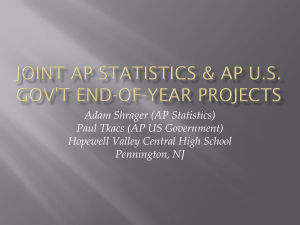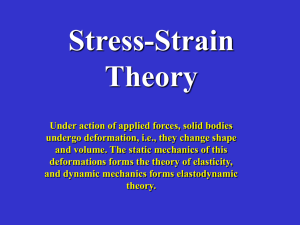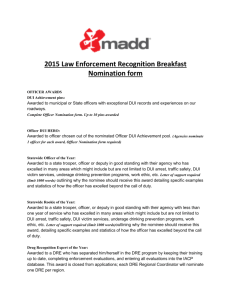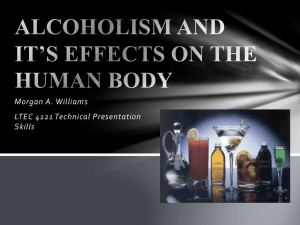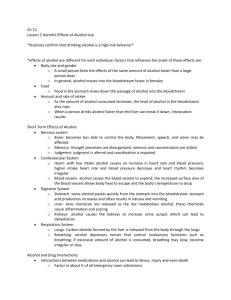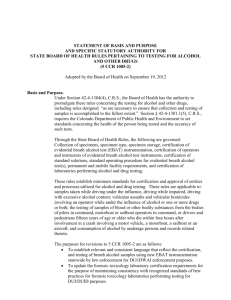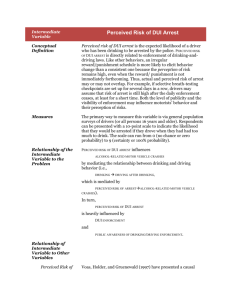Abstract - Tampa Alcohol Coalition
advertisement
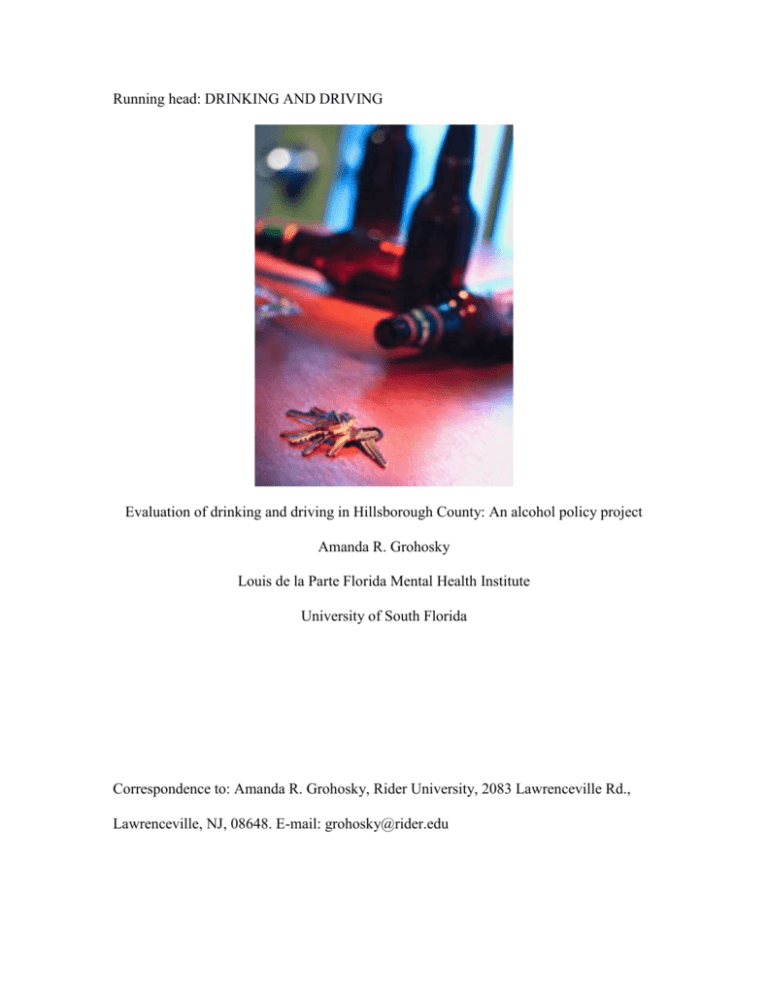
Running head: DRINKING AND DRIVING Evaluation of drinking and driving in Hillsborough County: An alcohol policy project Amanda R. Grohosky Louis de la Parte Florida Mental Health Institute University of South Florida Correspondence to: Amanda R. Grohosky, Rider University, 2083 Lawrenceville Rd., Lawrenceville, NJ, 08648. E-mail: grohosky@rider.edu Evaluation of drinking 1 Acknowledgements The completion of this project was in large part due to the support of the many agencies dedicated to reducing drunk driving and saving lives, so I would like to thank the fifteen agency representatives who eagerly agreed to participate in this study. Special thanks is due to the Hillsborough County Sheriff’s office, the Tampa Police Department, DUI Counterattack, and Tampa Crossroads for any data that was provided, as well as for accommodating me in my observations. Their hospitality is something to be commended. I would also like to thank Ellen Snelling, the chair of the Tampa Alcohol Coalition, for going the extra mile in all of the help she provided. Her passionate and ambitious commitment to the Coalition is both refreshing and inspiring, and it provided for a truly enriching experience. Graphics were handled by Carrie Wagner at the Florida Mental Health Institute, and computer software assistance was provided by Laura Pape and Deborah Rugs. Finally, Dr. Kathleen Moore, in the department of Mental Health, Law, and Policy at the Florida Mental Health Institute served as an exemplary mentor, making the experience a deeply rewarding one. Working with her has been an honor, and I am truly grateful for all she has done for me. As with any other work, this project reflects the efforts and help of many individuals with a passion for the pursuit of knowledge and an interest in the improvement of key issues within the community. To these individuals and the many others who took part in this project, I say thank you. Evaluation of drinking 2 Abstract Driving under the influence (DUI) is a serious crime that, despite various local and nationwide efforts to combat, contributes to an overwhelming number of crashes, fatalities, and arrests in the state of Florida. Specifically, Hillsborough County has the highest rate of alcohol-related crashes, fatalities and injuries. In 2005, Hillsborough County had a total of 7,134 DUI arrests, a 5.6% increase from the previous year (HCSO, 2006). Although this increase is reflective of heightened police efforts (e.g., DUI checkpoints and saturation patrols), it also represents a very high number of DUI offenders. This suggests that improving police enforcement is just the first step in cracking down on DUI offenders. There are several gaps in policy, enforcement, and treatment that need to be addressed before Hillsborough County is able to shed its label as a state leader in DUI occurrences. In this effort, fifteen key stakeholders involved in alcohol policy were interviewed on questions concerning law enforcement, judicial, and treatment considerations. Results found that several obstacles exist including little time to prepare a case, case overload, challenges to the prosecution such as leniency and inconsistency in sentencing, and the need for more collaboration between law enforcement, the legal system, and treatment providers. Suggested recommendations for improvement were the addition of a DUI court, stricter legal and treatment requirements, and mandatory blood testing at the time of arrest. Ultimately, a decrease in the number of DUI offenses will rely on the help of proactive and dedicated organizations like the Tampa Alcohol Coalition, which has been devoted to finding solutions to alcohol-related issues for the past five years. Evaluation of drinking 3 Introduction In every state, countless lives are lost each year and individuals are continually subjected to costly and lengthy penalties for driving under the influence of alcohol. In 2004, the National Highway Traffic Safety Administration reported a total of 17,105 alcohol-related fatalities nationally. Of these, 1,222 alcohol-related fatalities occurred in the state of Florida, accounting for 38% of Florida’s total number of traffic fatalities (NHTSA, 2005). Although these numbers show a decrease from 2003, they are still very high and demonstrate the need for continued efforts to ensure the further decline of such numbers. In addition, DUI carries just as heavy a legal burden as it does with regard to injuries and fatalities. Aside from license suspension, which can create severe inconveniences and extra expenses in light of costly public transportation, there are expensive penalties subsequent to a DUI arrest, including bail, court costs, fines, DUI treatment, license reinstatement, and vehicle impoundment, that can cost the offender thousands of dollars (Vallejo, 2005). Moreover, these costs do not include the costs for legal representation, increased fines and penalty for repeat offenders, as well as court mandated penalties, such as community service or extensive treatment (Vallejo, 2005). Clearly, the offense does not appear to be worth the consequences. However, despite studies addressing the magnitude of the health and legal risks associated with impaired driving (e.g., Clapp, Johnson, Voas, Lange, Shillington, & Russell, 2005; Nochajski & Stasiewics, 2006), organizations such as Mothers Against Drunk Driving (MADD), Remove Intoxicated Drivers (RID), and Students Against Drunk Driving (SADD) still struggle to find solutions (DeJong & Hingson, 1998). Evaluation of drinking 4 DUI Law Enforcement Efforts Even with the persistent efforts of such organizations, further improvement is needed both in law enforcement and in treatment considerations subsequent to arrest if DUI rates are going to be minimized. Nationally, many changes have already been made on each of these levels in an attempt to make law enforcement more effective and more efficient. As various studies demonstrate, though, not all of these changes have proven themselves fruitful. The following sections review numerous law enforcement efforts designed to reduce drinking and driving. Deterrence Theory. Several states in the past have relied on a deterrence theory, which has been identified as an ineffective “sine qua non tool of formal social control” in light of criminal law (Fradella, 2000). Specifically, methods of control that utilize a strict, objective approach to criminality, such as the implementation of a mandatory minimum sentence for DUI offenders, do not take contextual differences into consideration in determining a suitable penalty and ultimately are ineffective in preventing future misconduct. Also, as Fradella (2000) notes, “mandatory minimum sentences not only create an economic issue as an increase in the demand for jail space becomes apparent, but they severely complicate the logistics of the prison system as the notion of overcrowding comes into question.” Certainly there are other less costly ways to achieve the same results, as this classical deterrence practice appears to do little to reduce rates of drinking and driving. Ignition Interlock Device. Also seemingly ineffective is the introduction of the breathanalyzed ignition interlock device. This technological tool was created to prevent an intoxicated individual, based on blood alcohol levels, from starting his or her vehicle Evaluation of drinking 5 (Fulkerson, 2003). Although Fulkerson believes the device is an effective means of preventing later offenses, the reality is that this tool is both costly and impractical for incapacitation, rather than rehabilitation. As with many other innovations, there is a flaw in the consistent enforcement of such a tool, as well as in the lack of contextual consideration. Additionally, it must be recognized that there is always a question of reliability when technology is used in lieu of police enforcement. It can be argued that objective measures such as these are effective in sparking a minimal decrease in alcoholrelated crashes and fatalities. However, when costs are weighed against potential benefits, it becomes apparent that more substantive changes must be made in order to effect more significant improvement. DUI Courts. On the other hand, one potentially successful implementation is DUI courts, which have been modeled after drug courts to “hold offenders to a high level of accountability, while providing them with long-term, intensive treatment and compliance monitoring” (Huddleston & Wosje 2005). Even with appropriate enforcement, monitoring becomes a key issue in the system, since without proper monitoring, offenders are more unlikely to complete court mandated requirements (Hedlund & McCartt, 2002). Although relatively new and in need of much more extensive evaluation to determine effectiveness, the introduction of these new courts into the justice system is likely to provide the necessary monitoring component and to ensure compliance, especially of high-risk, repeat offenders because of specialized and intensified supervision (NHTSA, 2003). Generally, while funding such projects may prove to be difficult, this innovation is a promising one, as it appears to focus on the long-term reduction of DUI offenses, rather than objective means of the mere incapacitation of the Evaluation of drinking 6 offender without regard to the severity or context of the crime. If community support can be obtained, this “proactive approach to justice” will not only increase the efficiency of misdemeanor courts, but it will also “close the ‘revolving door’ of a criminal justice system dominated by substance-abusing repeat offenders” (Freeman-Wilson & Huddleston, 1999). Police Enforcement. Perhaps the most profoundly effective change to date has been in police enforcement, which “constitutes the front line in the fight to end impaired driving” (MADD, 2002). Extensive increases in the use of sobriety checkpoints and police saturation has led to an increase in the number of arrests made, and has thus decreased the number of offenders who go undetected and who consequently risk further and fatal harm to themselves and others. These checkpoints, which, according to a MADD report, have already been proven to be successful (MADD, 2002), are designed not only as a means of increasing arrests, but also as a general deterrence to those who know of and fear the operation (NHTSA, 2003). Although such a method likely decreases traffic efficiency and convenience, as it is both costly and time consuming, the benefits outweigh the risks tremendously, more than frequently removing intoxicated persons from the dangers of the highway and serve as a vehicle for public awareness. DUI Treatment Efforts In addition to law enforcement, treatment requirements subsequent to any arrest and court appearance are a crucial component in prompting a DUI reduction. Treatment considerations vary to include such programs as DUI Counterattack or DUI schooling, as well as intensive treatment programs, whether they be outpatient or residential. Although no one program is suitable for each kind of offender, they all seem to have both benefits Evaluation of drinking 7 and downfalls. DUI Counterattack. This program, which serves as a DUI schooling tactic for educating and evaluating offenders, seems an effective first step in responding to DUI, although it would likely serve a better purpose if combined with a treatment requirement. One particularly problematic component of this program is the different schooling requirements depending on the level of offense. There is a substantial difference between a 12-hour course and a 21-hour course, and little is presumably gained from the 12-hour course, which provides only a brief penalty for offenders. Schooling should certainly be required for every offender subsequent to sentencing, regardless of the case logistics. Variability should be exercised in different forms of treatment, as the ultimate goal should be to help the individuals, rather than to simply punish or lecture them. DUI Intensive Treatment.For some individuals, intensive treatment is a more effective and suitable requirement than schooling. With every type of outpatient service, there are individuals who fail to complete the program. Perhaps this failure could be explained because the offender had his or her license revoked or because of the lack of desire by the offender to complete his or her requirements. Regardless, it is the joint detention and treatment program that seems to have the most intensive requirements. In truth, such programs can be expensive and time-consuming, but it is also possible that they produce the most long-term effects for DUI offenders. Several studies have explored intensive treatment (e.g. Kunitz, Woodall, Zhao, Wheeler, Lillis, & Rogers, 2002), but most have only examined treatment groups consisting of first-time offenders, and the duration of such programs averages a mere 28 days. As a MADD report clarifies, individuals convicted two or more times of a DUI Evaluation of drinking 8 offense become what is called a “higher-risk driver” and, it is rationalized, these drivers require stricter guidelines and controls (MADD, 2002). Although this group of repeat offenders comprises only a small percentage of DUI offenders (Jones & Lacey, 2000), they are seen as a much greater risk to traffic safety. It has been suggested that mandatory sentencing, vehicle sanctions, as well as assessment and treatment stand as options for responding to these multiple convictions (MADD, 2002). However, there is certainly no question that additional response measures must be utilized to remove these liabilities from the roadways. It is evident that, even though numbers are still extraordinarily high, enforcement and treatment responses have been considered at great length and will continue to be adjusted and improved upon. However, although law enforcement, the legal system, and treatment providers have all been working hard to combat such a serious crime, these three community sectors need to create stronger ties and work together in order to significantly lessen the potential harm caused by DUI offenders. Hillsborough County, Florida’s state leader in DUI crashes and fatalities, has worked hard to form this collaborative among law enforcement, judicial, and treatment considerations. DUI Efforts in Hillsborough County, Florida For the last five years, the Tampa Alcohol Coalition (TAC), a local grassroots organization, has focused on alcohol-related issues in Hillsborough County, specifically underage drinking and driving under the influence. Members include representatives from law enforcement, the legal system, MADD, treatment providers, and other community organizations. The coalition would agree that heightened law enforcement alone, such as the utilization of sobriety checkpoints, is not a sufficient source for Evaluation of drinking 9 widespread recovery from the devastating rates of DUI. Changes need to be implemented in alcohol policy, such as regulating the purchase of alcoholic beverages, keg registrations, DUI laws, etc. With regard to treatment, new initiatives need to be explored, particularly those imposing intensive treatment on multiple DUI offenders, to allow for an understanding of what methods would efficiently reduce recidivism rates. However, without the perspective of those involved in such initiatives, as well as in law enforcement and the legal system, it would be difficult to induce significant change in Hillsborough County’s alcohol policy. One innovative program was recently funded involving the Hillsborough County Sheriff’s Office (HCSO), the State Attorney’s office (SA), and Tampa Crossroads, a treatment provider. The goal of this initiative is to work together to reduce the high rate of alcohol-related crashes, injuries, and fatalities. In this end, the HCSO has worked to increase its DUI enforcement countywide. Sobriety checkpoints are key to this expansion, and are responsible for a large increase in the number of DUI arrests (a 5.6% increase from 2004), hopefully decreasing the number of drunk drivers on the highways of Hillsborough County. In tandem, it has been the responsibility of the State Attorney’s Office to employ specialized investigations and aggressive prosecutions in dealing with this population of repeat offenders. They have hired a DUI prosecutor to manage the large number of DUI cases that are filtered through the legal system, particularly those involving repeat offenders. In an innovative effort to reorient the thinking patterns of repeat offenders and prevent future offenses, Tampa Crossroads utilizes counseling techniques to recreate each client’s sense of responsibility for each of his or her criminal behaviors. Overall, it can be Evaluation of drinking 10 presumed that the treatment program is designed, in part, to reduce recidivism rates among the least frequent, but arguably most dangerous, group of criminals in Hillsborough County. Generally, the initiative seems a promising answer to an issue that has long gone unsolved. Current Study In order to reduce the high DUI rate, this study conducted an alcohol policy project in Hillsborough County. More specifically, issues in alcohol policy, enforcement, and treatment were examined in order to identify these gaps and work toward finding solutions for the current DUI problem. This formative evaluation is meant to provide an understanding of how the system operates and how it can be improved in an effort to reduce the high rate of DUI offenses in Hillsborough County. Method Participants Participants in this study included fifteen key stakeholders, identified as experts or opinion leaders in alcohol-related issues in Hillsborough County. These stakeholders consented to a 45-minute interview with questions addressing alcohol policy, treatment issues, law enforcement considerations, gaps in the system, and efforts to overcome these barriers. The participants included community leaders from the Hillsborough County Sheriff’s Office, Tampa Police Department, the State Attorney’s office, treatment providers, the court system, MADD, and individuals associated with the Tampa Alcohol Coalition, all of whom play a role in combating the severe DUI issue in Hillsborough County. Table One provides a listing of the agencies whose representatives agreed to participate in the study. Evaluation of drinking 11 Table 1 Agencies represented in Key Informant interviews DUI Counterattack MADD The Walsh Group Tampa Crossroads Salvation Army Drug Court TPD University of Tampa State Attorney’s Office HCSO Division of ABT Misdemeanor Court Note. MADD = Mothers Against Drunk Driving; TPD = Tampa Police Department; HCSO = Hillsborough County Sheriff’s Office; ABT = Alcoholic Beverage and Tobacco Measures A ten question interview was developed by the researchers for this study and was used to determine attitudes toward alcohol policy and enforcement issues among the different agencies that serve as opinion leaders within the community. Each participant was asked to respond to questions regarding DUI (i.e. what has been done and needs to be done in law enforcement; gaps in the legal system in light of the arrest, charging, and sentencing of a DUI offender; and changes in alcohol policy that need to be implemented in order to perpetuate a significant decrease in DUI rates). Table Two provides a listing of the ten questions asked during each interview. Evaluation of drinking 12 Table 2 DUI Interview Questions 1. What role do you and your organization play in combating the DUI offenses (7,134 this past year)? 2. Can you please explain the different paths one may take within the legal system subsequent to a DUI arrest? 3. In your opinion, are there any gaps in the system in how a person is arrested, charged, convicted, and sentenced for DUI? 4. In terms of the different paths a person arrested for DUI may take, what might you suggest as the ideal treatment and/or legal requirement subsequent to DUI arrest? 5. What explanation can you offer with respect to the overwhelming number of DUI offenses within Hillsborough County in the past year (5.6% increase from 2004)? 6. Hillsborough County is a state leader in alcohol-related crashes and injuries. In terms of law enforcement, what do you think should be done to decrease these numbers? 7. The Tampa Alcohol Coalition has been in existence for the past several years working on various alcohol policy issues. Do you think it has been successful or not? Please describe. 8. What explanations might you attribute to repeat DUI offenses despite the legal consequences and/or completion of court mandated treatment? 9. Considering the actions currently being taken within law enforcement and the legal system, do you foresee a decrease in the number of DUI offenses in Hillsborough County over the course of the next several years? Please explain. 10. In your opinion, what are the major gaps and barriers with regard to alcohol policy in Hillsborough County? Design and Procedure For the purpose of this formative evaluation, a qualitative research design was used to explore recommendations for the improvement on alcohol policy in Hillsborough County and the reduction of DUI arrests, crashes, and fatalities. Fifteen interviews were structured around ten questions and conducted by the researchers at the Florida Mental Health Institute. Prior to conducting the study, the evaluation was approved by the University of South Florida’s Institutional Review Board (IRB). Participants provided their informed consent prior to the interview, and data were recorded with detailed notetaking by two researchers for coding and analysis purposes. In addition to the fifteen Evaluation of drinking 13 interviews, researchers conducted in-depth field work to collect data and gain a more thorough understanding of the process involved in a DUI offense. Table Three provides a listing of field activities and observations. Table 3 Data Collection Process 1. Conducted fifteen interviews 2. Attended meetings: Tampa Alcohol Coalition, Anti-Drug Alliance, MADD, City Council (topic on drink specials) 3. Observed two DUI checkpoints 4. Took part in two police ride-alongs with HCSO DUI officers 5. Accompanied four undercover officers to assess underage drinking in several bars in Ybor City 6. Observed Dependency Drug Court and Juvenile Drug Court 7. Observed a DUI Counterattack assessment Data Analysis The data from the fifteen interviews were analyzed using software by Microsoft Office 2003. Hand-written data were first entered into the computer and organized into categories using Microsoft Excel. To create comprehensive and representative categories, researchers grouped participants’ responses together based on common themes and word patterns. Once every response was accounted for, this grouping procedure was repeated several times in order to combine categories and make them more inclusive, and the total number of responses for each category was arranged into bar graphs for each interview question. Each graph details the number of responses appropriate to each assigned category in descending order from left to right. Evaluation of drinking 14 Results The fifteen participants that were interviewed represent agencies with a vested interest in alcohol-related issues within the community. Each demonstrated a profound dedication to the efforts in Hillsborough County, pointing to some of the key gaps and barriers in alcohol policy and offering numerous recommendations for reducing and preventing DUI offenses. Participants also provided helpful insight into the arrest process, explanations for multiple offenses, and the success of the Tampa Alcohol Coalition. The following sections highlight results in detail with accompanying figures. Process Following a DUI Arrest Before gaps in the time between a DUI arrest and conviction can be discovered and thoroughly understood, the process itself must first be explored. The flow chart represented in Figure One was created after a series of interviews and field observations (e.g. DUI checkpoints, police ride-alongs, court system observations, etc.). This chart illustrates the different paths an individual can generally take subsequent to a DUI arrest. In addition to knowing about the logistics of the legal route, it is important to understand how the numbers of arrests are filtered through the system. Every person convicted of DUI is required to go to DUI Counterattack where he or she receives schooling and an assessment to determine a need for treatment. Figure Two details the breakdown of the 7,134 arrests in 2005, illustrating the number of those arrests that went to DUI Counterattack and were then referred to some type of treatment program. Evaluation of drinking 15 Figure 1 Flowchart of DUI Process Evaluation of drinking 16 Figure 2 Flowchart of DUI Arrests and Education/Treatment 7,134 DUI Arrests 5,729 DUI Counterattack 4,060 (71%) 1st Time 1,669 (29%) Multiple 2,517 (62%) Referred to Treatment 1,636 (98%) Referred to Treatment Note. DUI Counterattack numbers are not solely representative of Hillsborough County. The numbers include out-of-state arrests and do not account for arrests made in Hillsborough County of residents from neighboring counties. Explanations for the High Rate of DUI Offenses Responses supported the notion that issues surrounding impaired driving go beyond just those in the context of the legal system. During the interviews, participants gave their opinions in light of the social issues that are at the root of the problem. The most highly stressed factor related to the overwhelming number of DUI offenses in Hillsborough County was that of an increasingly alcohol-dependent social climate. One participant commented that “it’s a way of life to have a six-pack.” Another contemplated the high acceptance and accessibility of alcohol in the community, exclaiming that “alcohol is everywhere,” and suggested a social misunderstanding of the difference between drunk Evaluation of drinking 17 and impaired. As the individual stated, there is often a wrong assumption made that “if an individual is not very drunk, then he or she is ok.” Participants also pointed to such issues as the population increase, the lack of public transportation to meet the travel needs of this growing population, and marketing tactics employed by drinking establishments that foster an encouragement to drink. Figure Three provides an illustration of the number of responses regarding explanations for DUI offenses, organized into seven categories. Figure 3 Explanations for High Number of DUI Offenses 20 # of Responses 15 10 5 0 So ci al A cce Me ssa ge Da ng ero DU IN ot Po pu l at / M us/ aP pta Un ri o ark nce edu rit e t y i & n c a g De ted & pen Pr M om ent den oti ali cy on ty ion Re gio Inc rea s La nal C e ck in T ha rac ter ra n spo isti c s rta t ion Explanations for Multiple DUI Offenses Participants offered several explanations as to why some individuals continue to drink and drive despite previous legal or treatment requirements. Most common among the responses was that such individuals are either alcoholics or they are not being penalized strongly enough to be impacted. In fact, one participant stated that “either there is an Evaluation of drinking 18 alcohol problem that is not being dealt with or the offender is completely irresponsible and doesn’t care.” In terms of the necessity for harsher consequences, one individual claimed that “they just need to go to jail.” Instead of the convenience and accommodation of the offender being considered in light of penalties, “the rules should just be the rules.” Figure Four provides an illustration of the number of responses regarding explanations for multiple DUI offenses, organized into five categories. Figure 4 Explanations for Repeat DUI Offenders # of Responses 10 5 0 No t en ou Alc oh gh Co n seq u oli sm Me nta enc es lit y Ac ces sib ilty /R Ne ed Tr ea eso u rce s tm ent Success of the Tampa Alcohol Coalition Data collected during the interview process emphasize the successful efforts put forth by the Tampa Alcohol Coalition in the last five years. Participants had a number of positive things to say about the organization, commenting frequently on the extraordinary amount of community involvement and communication it ignites. The organization was Evaluation of drinking 19 deemed both proactive and collaborative by several participants who marvel at the work the coalition has done with law enforcement and the community, alike. A valuable community resource, the Tampa Alcohol Coalition, as one individual noted “has really just done a lot.” Figure Five provides an illustration of the number of responses regarding the success of the Tampa Alcohol Coalition, organized into four categories. Figure 5 The Tampa Alcohol Coalition 16 # of Responses 12 8 4 0 Co mm un ity Or gan In v olv em ent iza tio n/D e Co l la bo rat ion dic at ion Va l ua b le Re sou rce Gaps in the System There are several significant gaps and barriers in light of the process that an individual goes through from a DUI arrest to the trial, conviction, and sentencing that were indicated in participants’ responses during the interview process. One very common suggestion was given with respect to the issues of leniency in prison sentencing and other Evaluation of drinking 20 legal or treatment requirements. As one participant declared, “people should be afraid to get a DUI, but they aren’t.” Additionally, the high number of challenges faced by prosecution in bringing each case to court was commonly discussed. Perhaps the most prevalent of these, as many participants maintained, is the ability of an individual to refuse a breath test, as it minimizes the amount of evidence the prosecutor can bring to the jury. Other mentioned gaps include the overwhelming number of cases brought to the state attorney’s office, the little time given to the prosecutor to process and resolve each case, and the minimal amount of communication between law enforcement, the state attorney’s office, and treatment providers. Figure Six provides an illustration of the number of responses regarding gaps in the system, organized into seven categories. Figure 6 Gaps and Barriers in the System 25 # of Responses 20 15 10 5 0 Ch Le DU Lit Ca Inc La nie se all tle ck on IN Ov eng ncy si st of Tim o t e Co es e a r i n et nS loa Pri cy lla to oP d ent bor Pr ori i n rep ose enc S en ty ati a cu t on in g re ten ion Ca cin se g Discussion Findings suggest that there are numerous issues at the root of the overwhelming DUI Evaluation of drinking 21 problem in Hillsborough County that need to be examined if changes are to be made. Hedlund and McCartt maintain that “drunk driving control is a long slow process of modifying social norms and practices regarding drinking and driving” (Hedlund & McCartt, 2002), but this is only a half truth. In fact, social change, however necessary to improvement, must be accompanied by changes in prevention policy, law enforcement, the legal system, and treatment in order to be successful. While society is a predominant source of alcohol-related issues and cannot be ignored, findings support the notion that gaps in the system need to be highly considered, since that is where the most immediate changes can be made. Recommendations There are several innovative ways to improve upon the gaps and barriers in alcohol policy, law enforcement, the judiciary, and treatment for a DUI offense. The following section highlights recommendations for the reduction of the number of DUI offenses in Hillsborough County. Harsher Laws and Penalties. It was found that many responses addressed the issues of leniency and inconsistency in the legal system. Many participants opted either for the implementation of stronger, harsher laws, or for the stricter use of the laws already in place. It was voiced by some that the current laws are applied too loosely, as one individual suggested that “laws shouldn’t be stronger; we just need to enforce the ones we have.” In truth, strengthening certain sanctions would aid law enforcement in becoming more efficient in handling a DUI arrest. For instance, mandatory blood testing at the time of arrest would decrease the amount of time spent on each individual DUI arrest. Currently, one DUI arrest can take an officer several hours to complete, as it is a Evaluation of drinking 22 very specific and thorough process. With blood testing at the time of the arrest, which is done in other states, the time normally spent at Central Breath Testing, the BAT Mobile, and Central Booking would become time spent back on patrol. Similar to this idea is the notion of mandatory breath or urine testing, stripping the offender of the right to refuse. One participant argued that “driving is not a right. It is a privilege. People should have no right to refuse to blow.” Others suggested that harsher penalties, such as jail, be put into place for a refusal to take a breath test, rather than the current penalty of a year of license suspension. While this may bring the constitutional debate to the surface regarding the individual’s right against self incrimination, it is certainly something to be considered. Inclusion of a DUI Court. Another way to address the leniency and inconsistency in trial and sentencing, and perhaps the most promising, would be the inclusion of a DUI court. Presently in misdemeanor courts, not all judges will order treatment so there is an issue of subjective bias in sentencing. In fact, one participant commented that, since DUI Counterattack completes an assessment of each client and refers many individuals to treatment, the “integrity of the system is preserved” and treatment is not the responsibility of the judge. However, this should not be the case. Especially for multiple offenders, treatment is an important component for preventing future offenses, but it is often overlooked by those who do not fully understand the need for treatment or who are too concerned with punishment. A DUI court, similar to drug court, would give higher priority to treatment and establish more consistency among judges who would preside over DUI cases only. Evaluation of drinking 23 Increase in Education. More education offered to everyone involved in the system (i.e. law enforcement, judges, attorneys, civilians who would potentially serve as jury members, etc.) would further decrease the inconsistencies from one DUI case to the next. As one participant explained, individuals don’t always understand how to correlate a specific blood alcohol level with impairment, so when breath test results are used as evidence in court, they are often times misunderstood or disregarded completely. Individuals in the system thus need to be informed of such logistics of a DUI case to fully understand how impaired an offender had been at the time of his or her arrest. Collaboration Among Key Stakeholders. The high need for collaboration between law enforcement, the State Attorney’s office, and treatment providers was addressed by the DUI initiative funded by the Justice Assistance Grant. However, in recent years, meetings and communication has decreased. As one individual noted, “These three areas need a common focus and common goals. It can’t just be a collaborative on paper. That’s not the point.” To improve the amount and quality of communication, quarterly meetings could be implemented as a way for these groups to come together to voice their opinions and bring issues to the surface. Judges should also attend these meetings, as it has been suggested that they become more closely involved in the process than they presently are. Increased Public Awareness. Continued and heightened public awareness campaigns are vital to combating DUI offenses. Law enforcement has done a wonderful job in promoting awareness with the DUI checkpoints, and the Tampa Alcohol Coalition is dedicated to targeting underage drinking with many of their messages, but more can always be done. It was suggested that awareness and education be given to younger children and adolescents. One individual explained that drinking habits start increasingly Evaluation of drinking 24 younger and younger, yet education is still targeting the same age group. Drinking needs to be addressed before it becomes a problem in order for the message to be effective. In light of the need for increased public awareness and education, another individual commented that “we are never going to stop people from drinking. We just need to make it safer.” Because alcohol is legal, it will be difficult to eradicate the social acceptance that surrounds it, but individuals can be informed of the perils associated with alcohol, and both children and parents can be educated about alcohol-related issues. Vigorous campaigns are one of the only ways to counteract the influence of drinking establishments on the community. Increased Transportation. In truth, Tampa’s rural highway systems and regional characteristics cannot accommodate the growing number of people living or the number of bars concentrated in certain areas. There is a dire need in Hillsborough County for an improvement in the public transportation system, and such would undoubtedly help to reduce the number of DUI arrests, crashes, and fatalities in the area. Geographically, Tampa is a very spread out city that makes it necessary for individuals to drive in order to go out. Perhaps, as one participant noted, there could be a line of cabs outside the bars, rather than the individual having to dial a cab company for service, or buses could run later than they presently do. Limitations Although there are a number of potential solutions to the high rate of DUI offenses in Hillsborough County, there are barriers associated with these solutions that must be considered. The following section reviews some of the key issues that need to be addressed before action can be taken. Evaluation of drinking 25 Funding. Particularly in reference to the implementation of a DUI court and the increase in public transportation alternatives, the availability of resources comes into question. Receiving funding is a competitive process that often times widens the gap in collaboration between agencies (Freeman-Wilson & Huddleston, 1999). Moreover, adding a DUI court to the legal system would require several new judges who specialize in DUI cases. It would undoubtedly become very expensive and difficult to attain these highly specialized judges. With regard to public transportation, there is also a large issue surrounding the expense of implementing such a large-scale project. The process can also often be a lengthy one which sometimes creates a hindrance to immediate and effective change. Recruitment. In pushing for change, it can be difficult to find enough individuals with a vested interest in the topic matter who would be willing to help. The unfortunate truth is that not many officers or judges want to dedicate all of their time to DUI cases. Additionally, education becomes a factor, especially in discussing the matters of the DUI Court and law enforcement. This is because hiring more DUI officers and specialized judges would require a great deal of education about blood alcohol levels, as well as treatment options and components. The training system that would need to be in place would require time and individuals willing to help. Support and Dedication. It is likely easier to find funding sources when there is support for the proposal. However, aside from funding, support is a crucial aspect of any movement toward change. It is apparent that drinking and driving is an issue that is not always a high priority in this community. Thus it may prove difficult to gain the support that is necessary for programs to be put into place. Hillsborough County will need to rely Evaluation of drinking 26 on dedicated organizations to bridge the gap in the community. Conclusions DUI has become a leading issue in recent years in Hillsborough County, and vigorous efforts to combat it should certainly be applauded. However, these efforts alone have come up short, as the rate of offenses has not yet decreased. Even with the numerous recommendations for change, significant improvement will rely on the continued and committed collaboration of the Tampa Alcohol Coalition with stakeholders and community leaders who are involved in alcohol policy. With the help of the Coalition and other dedicated organizations, combined with community support and the continued vigilance of law enforcement, the implementation of many of the goals put forth in this report can become a reality. The Coalition has a voice that is heard, and it can help to facilitate the much needed communication between law enforcement, the judiciary, and treatment providers. If these areas can come to a collaborated understanding of the DUI rate and how to fix it together, then we will begin to see substantial improvements in Hillsborough County. Evaluation of drinking 27 References Clapp, J. D., Johnson, M., Voas, R. B., Lange, J. E., Shillington, A., & Russell, C. (2005). Reducing DUI among US college students: Results of an environmental prevention trial. Addiction, 100, 327-334. Dejong, W., & Hingson, R. (1998). Strategies to reduce driving under the influence of alcohol. Annual Reviews of Public Health, 19, 359-378. Fradella, H. F. (2000). Mandatory minimum sentences: Arizona’s ineffective tool for the social control of driving under the influence. Criminal Justice Policy Review, 11(2), 113-135. Freeman-Wilson, K., & Huddleston, C. W. (1999). DWI/Drug Courts: Defining a national strategy. Fulkerson, A. (2003). Bow and go: The breath-analyzed ignition interlock device as a technical response to DWI. The American Journal of Drug and Alcohol Abuse, 29(1), 219-235. Hedlund, J. H., & McCartt, A. T. (2002). Drunk driving: Seeking additional solutions. Huddleston, C. W., & Wosje, R. (2005). DWI courts: A promising sentencing innovation. Jones, R. K., & Lacey, J. H. (2000). State of knowledge of alcohol-impaired driving: Research on repeat DWI offenders. Kunitz, S. J., Woodall, W. G., Zhao, H., Wheeler, D. R., Lillis, R. , & Rogers, E. (2002). Rearrest rates after incarceration for DWI: A comparative study in Southwestern US County. American Journal of Public Health, 92(11), 1826-1831. Mothers Against Drunk Driving (2002). It’s time to get MADD all over again: Resuscitating the nation’s efforts to prevent impaired driving. Evaluation of drinking 28 National Highway Traffic Safety Administration (2003). Initiatives to address impaired driving. National Highway Traffic Safety Administration (2003). You drink & drive. You lose. National crackdown: Small scale sobriety checkpoints. National Highway Traffic Safety Administration (2005). Traffic safety facts. Nochajski, T. H., & Stasiewicz, P. R. (2006). Relapse to driving under the influence (DUI): A review. Clinical Psychology Review, 26, 179-195. Shults, R. A., Sleet, D. A., Elder, R. W., Ryan, G. W., & Sehgal, M. (2002). Association between state level drinking and driving countermeasures and self reported alcohol impaired driving. Injury Prevention, 8, 106-110. Vallejo, J. (2005). Obvious choice: Alcohol and drug impaired driving awareness.
